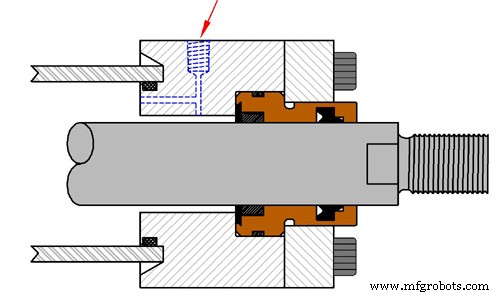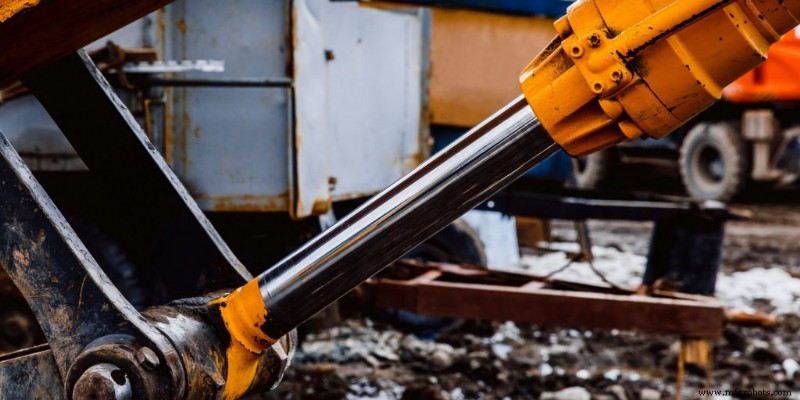Müssen Hydraulikzylinder entlüftet werden?
Viele Leute glauben, dass das Entlüften von Hydraulikzylindern eine Arbeit ist, die nur dann notwendig ist, wenn etwas schief geht und die Pumpe nicht anspringt. Aber ist das wirklich so? In diesem Artikel sehen wir uns an, warum Sie möglicherweise einen Hydraulikzylinder entlüften müssen und was das Verfahren beinhaltet.
Was sind Hydraulikzylinder?
Hydraulikzylinder werden in vielen Anwendungen verwendet, einschließlich Flugzeugen, Automobilen und landwirtschaftlichen Maschinen. Sie bestehen aus einer Reihe miteinander verbundener Röhren, die Flüssigkeit oder Gas unter Druck setzen, um Bewegung zu erzeugen.
Hydraulikzylinder werden typischerweise verwendet, um Geräte wie Pumpen, Lüfter und Motoren anzutreiben. Sie können auch verwendet werden, um Objekte oder Flüssigkeiten kontrolliert zu bewegen.
Hydraulikzylinder gibt es in verschiedenen Größen und Formen. Sie bestehen oft aus Metall oder Kunststoff. Sie können entweder Einzel- oder Mehrzylindereinheiten sein.
Was ist das Entlüften von Hydraulikzylindern?
Wenn Sie ein Problem mit Ihren Hydraulikzylindern haben, ist es wichtig, sie zu entlüften. Das Entlüften Ihrer Zylinder hilft dabei, Schmutz zu entfernen, der die Kolben und Ventile blockieren könnte, und stellt die Zylinder wieder in ihren Betriebszustand.

Arten von entlüftenden Hydraulikzylindern
Das Entlüften von Hydraulikzylindern ist ein wichtiger Bestandteil der Wartung und des reibungslosen Betriebs der Ausrüstung. Es gibt verschiedene Arten von Hydraulikzylindern zum Entlüften, daher ist es wichtig zu wissen, welchen Sie entlüften müssen.
Der gebräuchlichste Typ von Entlüftungshydraulikzylindern ist der Spritzentyp. Dieser Zylindertyp hat einen Kolben, der in eine Armatur an der Maschine passt. Der Kolben wird nach oben und unten gedrückt, und wenn er den Boden erreicht, wird die Flüssigkeit durch die Armatur auf den Boden gedrückt. This type of cylinder can be bled using a pressure bleeder or a vacuum bleeder.
The pressure bleeder uses air pressure to push the fluid out. To use this type of bleeder, you first need to raise the pressure in the machine by turning up the gas or oil valves. Then, connect the bleeder tube to the fitting on the machine and open the bleed valve. Next, pressurize the bleeder tube by pumping air into it until the gauge reads 100 psi (pounds per square inch). Finally, close the bleed valve and wait until the gauge reads 0 psi before releasing the air pressure.
The vacuum bleeder uses suction to push the fluid out. To
Why would you bleed hydraulic cylinders?
Most hydraulic systems use pressurized hydraulic fluid to operate the machinery. The hydraulic pressure is created when the liquid is forced through a valve and into a pipe. When the system needs to be repaired, it’s often necessary to bleed the hydraulic cylinders by draining off the pressure.
Bleeding the cylinders allows air and other contaminants to escape and prevents them from building up, potentially causing damage to the equipment or even a fire. It’s also important to bleed the cylinders regularly if you’re using synthetic oil or any other type of lubricant, as these will add volatility and pressure to the system.
Are there any risks to bleeding a hydraulic cylinder?
There are a few risks to bleeding hydraulic cylinders, but they are generally quite low. One potential risk is that the cylinder could rupture, resulting in severe injuries. Another risk is that the fluid could come out in a harmful or explosive manner. In either case, however, the likelihood of these risks occurring is very low.
How to Bleed a Hydraulic Cylinder
Bleeding hydraulic cylinders is an important step in maintaining hydraulic system performance. This procedure cleans and lubricates the components and helps prevent corrosion. To bleed a cylinder, you will need the following supplies:
-Cylinder
-Bleed screw
-Locknut
-Wrench
-Hose clamp
-Hydraulic fluid
-Container to store fluid (optional)
To bleed a cylinder, start by attaching the bleed screw to the cylinder head. Tighten the locknut until the bleeding is complete. If you are using a container to store fluid, attach the hose clamp to the container and connect it to the bleed screw. Turn on the hydraulic fluid and wait for the cylinder to fill with fluid. Once it has filled, turn off the hydraulic fluid and remove the bleed screw.
When to Bleed a Hydraulic Cylinder
If you are seeing hydraulic fluid leaking from your hydraulic cylinder, it is most likely time to bleed the system. Here are four reasons you may need to bleed a hydraulic cylinder:
-A bypass valve has been opened inadvertently, allowing fluid to escape from the cylinder and into the system.
-The cylinder seal has failed, allowing air and fluid to mix and create leaks.
-The piston has become stuck in the cylinder, preventing it from moving and creating a pressure build-up.
-The hydraulic system has been damaged in some way and needs to be repaired or replaced.

How to find the correct cylinder to bleed
There are a few things to keep in mind when bleeding hydraulic cylinders. The first is the type of cylinder you have. There are three types of hydraulic cylinders- internal, external, and mixed. Each has its own specificBleed procedure.
Internal cylinders can only be bled through the Schrader valve on the side of the cylinder. External cylinders have a bleed port on one end that can be used to bleed them, and they also have a Schrader valve on the other end. Mixed cylinders have both types of valves- one on each end.
The next thing to consider is the pressure rating of the cylinder. Most industrial applications require a pressure rating of at least 300 psi. If you’re not sure what your pressure rating is, check with your manufacturer or look it up online.
Now that you know some basics about bleeding hydraulic cylinders, it’s time to get started! Here’s a step-by-step guide to bleeding an internal cylinder:
1) Turn off the power to the machine and remove any stray objects that could get caught in the machinery.
2) Open the bleed port on the side of the cylinder (if applicable) and insert a suitable tube into
Schlussfolgerung
Bleeding hydraulic cylinders is a necessary task to keep your equipment in working order. However, it can be an extremely challenging and time-consuming process. In this article, we will discuss the different methods that are available for bleeding hydraulic cylinders and provide you with tips on how to successfully execute the task. We hope that this article will help make bleeding hydraulic cylinders a little bit easier for you.
Do you need to bleed hydraulic cylinders,please click topkitparts see more
Industrielle Ausrüstung
- Brauchen Sie neue Sturmbremsen?
- Was sind hydraulische Klemmen und warum brauchen Sie sie?
- Was Sie über hydraulische Hilfsbremsen wissen müssen
- Auswahlhilfe für Hydraulikzylinder
- Alles, was Sie über hydraulische Pressen wissen müssen
- wie man eine Hydraulikpumpe entlüftet
- Müssen Sie ein Hydrauliksystem entlüften?
- Wie testet man eine Hydraulikpumpe?
- Muss meine Hydraulikpumpe repariert werden?
- Sind kundenspezifische Hydraulikzylinder für Sie geeignet?



